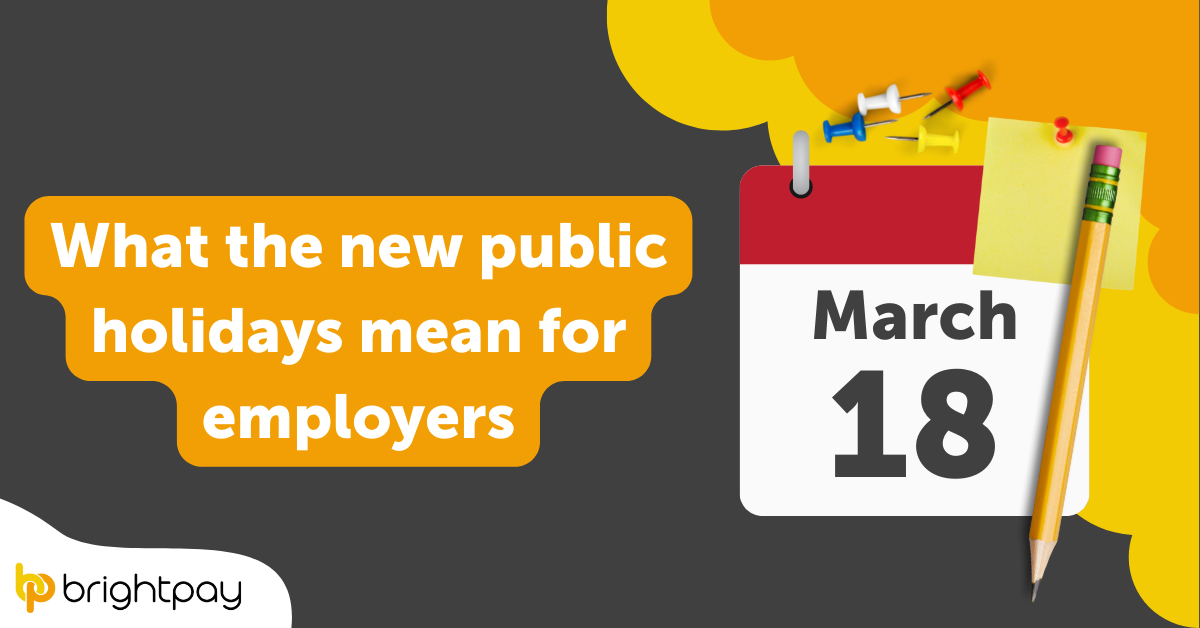Mar 2022
14
What the new public holidays mean for employers

Did you know that the introduction of Ireland’s new public holiday brings us to a total of 10 public holidays per year? This brings us more in line with the rest of Europe, as the average number of public holidays stands at about 10-14 per year. Some countries such as Slovakia have an even higher number, with 15 public holidays per year.
Here at BrightPay, we provide the most up-to-date information on important changes to your payroll process, including any legislative changes related to Revenue. From the implementation of PAYE Modernisation to our integration with multiple APIs, we make sure that your payroll workflow is completely streamlined and fully compliant.
What date is the new public holiday in Ireland?
The extra public holiday in Ireland this year is on the 18th of March 2022, however, this is just a once-off case. The new public holiday that’s being permanently implemented will be happening on the first Monday in February, commencing from 2023. This has been implemented to honour Ireland’s most famous female saint, St. Brigid.
What if the 1st of February is a Friday?
If the 1st of February happens to fall on a Friday, then the February bank holiday will happen on that Friday, rather than the following Monday.
Why is there an extra public holiday in March this year?
The extra public holiday for March 2022 was brought into effect to recognise the efforts of the public and in remembrance of the 9,000 people who have lost their lives during the COVID-19 pandemic.
This extra public holiday results in Ireland now enjoying a well-deserved four-day weekend this March, alongside the celebrations for St. Patrick’s Day.
Not only that, but the government is also taking this a step further, by gifting a recognition payment to eligible frontline healthcare workers. This recognition payment will consist of a once-off €1,000 that won’t be subjected to income tax, PRSI, or USC.
How do I pay employees during a bank holiday?
If your employees are working during a public holiday, they are entitled to an additional day’s pay. This also applies if a public holiday happens to fall on a weekend.
If employees aren’t working that day, they have the right to choose an alternative option at least 21 days prior to that public holiday. These alternatives could include a paid day off on the public holiday or an additional day of annual leave.
Part-time employees should also receive an additional day’s pay if they are working during a public holiday.
If your part-time employees aren’t working that day, they are entitled to a day’s pay if they’ve worked at least 40 hours over the previous five weeks and if they normally work on the day of that public holiday.
If they don’t meet both of these criteria, then they are entitled to one-fifth of their weekly pay.
For further information on what employees are entitled to during public holidays, please take a look at the Organisation of Working Act 1997.
How can I manage employees’ leave better?
Whether it’s public holidays or annual leave, it can all be quite hard to manage and can feel overwhelming sometimes for you as an employer.
Some employers manage their employees’ annual leave though outdated methods such as handwritten notebooks and complex excel files. Here at BrightPay, we find that these methods are not only prone to error, but they’re also incredibly time-consuming, taking up a considerable amount of admin work, especially over holiday periods.
Our cloud extension, BrightPay Connect, can provide your employees the ability to request annual leave through our user-friendly employee app at the tap of a button on their phone or smart device. Employees can view their annual leave through a built-in calendar format, where they can see their leave for the entire year.
You as the employer can then simply log into your desktop and either accept or reject employees’ annual leave requests. This is all done through the simple and easy-to-use calendar format, where you can view all of your employees leave for the year.
Employees then receive a notification when you have updated their request submission via their employee app.
BrightPay Connect also provides many other features, including:
- Employer dashboard that allows you to view employee details, payslips and any outstanding payments due to Revenue
- Automatic cloud backup of your payroll data every 15 minutes, guaranteeing the safety of your payroll data by storing it in a secure and remote location.
- HR document hub where you can upload any important HR documents, including contract of employment. You can also control which departments/employees have access to specific documents.
- Employee self-service portal where employees can download and print any of their payslips from anywhere at anytime.
- Increases your GDPR compliance by allowing employees to have more control over their data while improving the security of that data.
Watch this quick one-minute video on how BrightPay Connect can enhance your business today.
Interested in learning more? Why not sign up for a free 15-minute demo for a more in-depth explanation on how BrightPay Connect can work for you as an employer.
How can I stay up-to-date on important future updates?
Here at BrightPay, we are constantly finding innovative ways to make your payments to employees as smooth and seamless as possible.
We are up-to-date on all the latest Revenue regulations to ensure the competency and efficiency of your business. We also hold webinars on a regular basis with industry thought leaders, where we go into further depth on particular topics of importance.
We recently hosted a webinar on changes to the EWSS since the 1st of February, where we discussed the recent changes to the Employment Wage Subsidy Scheme, along with some questions and answers at the end. To view more upcoming webinars over the next couple of weeks, just click the link below.
Related articles:









